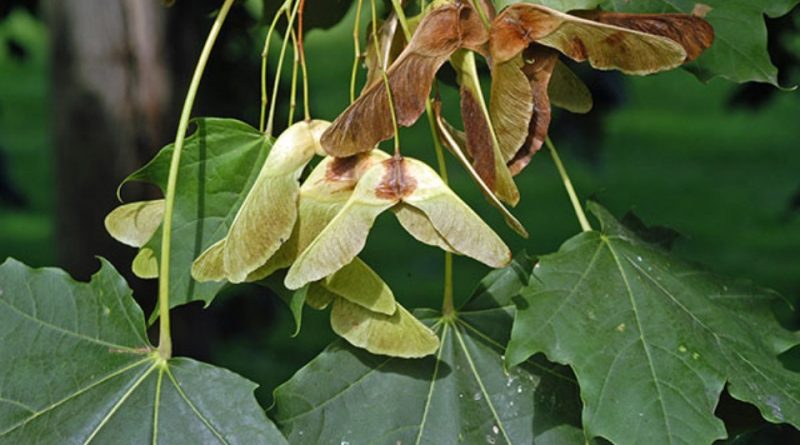Acer platanoides
Acer platanoides
Curly or platanoid maple (Acer platanoides L.) is an arboreal species belonging to the Sapindaceae family.
Systematics –
From the systematic point of view it belongs to the Domain Eukaryota, Kingdom Plantae, Magnoliophyta Division, Magnoliopsida Class, Order Sapindales, Family Aceraceae and therefore to the Genus Acer and to the Species A. platanoides.
Etymology –
The term Acer derives from the Latin name dell’Acero, cited in Pliny and Ovid. This name should derive from pointed, pungent acer acris, both for the pointed shape of the leaves and for the use of maple to make lances. The specific epithet platanoides comes from the Greek εἶδος eidos, semblance: that is, it resembles the plane tree for the shape of the leaves.
Geographic Distribution and Habitat –
The Acer platanoides is a spontaneous species in many damp and sheltered deciduous forests, native to Central and Eastern Europe. It is accompanied by other maples, especially Acer pseudoplatanus, (both have similar bears) in the central-northern mesofile ravines. Its range expands much further north than other local maples, occupying all of Europe with the exception of the Atlantic regions (Iberian peninsula non-Pyrenean, English Isles, Western France, the Netherlands, Denmark), from northern Spain to the southern part of Scandinavian, up to the Caucasus. In Italy it is located in the center-north.
Description –
The Acer platanoides is characterized by an arboreal habit, even if some ornamental varieties have a bushy shape with a conical-pyramidal low crown, with conical-globose and dense foliage. The plant can reach heights up to 15-20 meters, with a straight trunk, branched in the middle-upper part, greyish rind with darker and rougher shades in the older trees. The leaves are deciduous, palmate with 5 shallow and toothed lobes, with 10-15 cm long lamina, glabrous and with long petiole and with a more or less intense green color. Some ornamental varieties have red-violet or variegated green leaves of white at the edges. The flowers are yellowish or greenish yellow, depending on the variety; they have 5 petals and sepals, with antesis in the period of April-May. The fruits are samare with divergent wings of 160 ° with long peduncle.
Cultivation –
The hedgehog can be grown in full sun or partially in the shade and adapts very well to any type of soil, although preferring those of medium texture, well drained, rich in humus, tend to loose. Also in terms of pH it is quite tolerant while finding better conditions in neutral or basic ones. It is a plant that has a high tolerance to salt soils.
Uses and Traditions –
Of this species there are three varieties among the most widespread:
– Columnaris: it is a plant characterized by a very compact posture, narrow columnar of the crown and by a better angle of insertion of the branches on the trunk; cultivated both with a columnar bearing from the base and a small tree with scaffolding of the branches at various heights; it does not require pruning and proves to be particularly suitable for tree-lined avenues, limited urban spaces and small gardens.
– Crimson King: it is a plant appreciated for its very elegant compact hair and in particular for the very ornamental leaf with a dark red color. It is resistant to air pollution, requires low maintenance and requires no pruning.
– Globosum: it is a small tree characterized by a compact and enlarged spherical foliage, with large palmate leaves that in autumn take on a yellow-gold color; it does not require high maintenance or pruning and is ideal for avenues in small areas and small gardens.
The Acer platanoides, also for its different varieties, is often cultivated for ornamental purposes in varieties with red leaves.
With rapid growth, it is not very long-lived: it is calculated around 150 years. The cream-white wood is very hard and is used for inlays, furniture and lathe work.
Preparation Mode –
Curly Maple has no other specific food or pharmaceutical uses.
Guido Bissanti
Sources
– Wikipedia, the free encyclopedia.
– Treben M., 2000. Health from the Pharmacy of the Lord, Advice and experience with medicinal herbs, Ennsthaler Publisher
– Pignatti S., 1982. Flora of Italy, Edagricole, Bologna.
– Conti F., Abbate G., Alessandrini A., Blasi C. (edited by), 2005. An annotated checklist of the Italian vascular flora, Palombi Editore.
Warning: Pharmaceutical applications and alimurgical uses are indicated for informational purposes only and do not in any way represent a medical prescription; there is therefore no liability for their use for curative, aesthetic or food purposes.


